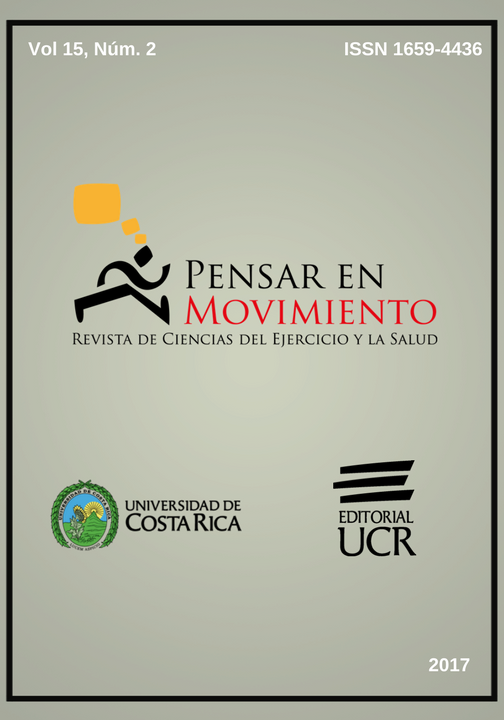Resumen
The effect of music on exercise performance has been studied from many perspectives, but the results have not been as clear as expected, probably because of a lack of appropriate controls. The purpose of this study was to measure stationary cycling performance in a warm environment under carefully controlled conditions, modifying only the presence of music and its tempo. Ten physically active students, 24.5±3.6 years (mean±SD) selected their favorite exercise music and performed a maximum cycling test. During subsequent visits to the laboratory, they pedaled at their preferred speed against a constant resistance (70% of maximum) in an environmentally controlled chamber (28.6±0.5 °C db and 65±3% rh) for 30 min, on three different days, without music (NM), medium tempo music (MT-120 bpm) or fast tempo music (FT-140 bpm), in random order. Perceived exertion (PE), heart rate (HR) and total work performed (W) were recorded. There was no significant difference among conditions for PE (4.47±1.52; 4.22±1.5; 3.83±2.06 a.u. for NM, MT and FT, respectively, p=.162) or HR (142.4±24.53; 142.6±24.37; 142.9±18.36 bpm for NM, MT and FT, respectively, p=.994), but W was different (43.4±19.02; 46.1±20.34; 47.1±20.97, kJ for NM, MT and FT, respectively, p=.009); post-hoc analysis showed that the W difference was only between FT and NM. Using individually selected preferred music in a carefully controlled environment, participants improved their spontaneous cycling performance only when the music had a fast tempo of 140 bpm.
Citas
Aburto, J., & Aragón-Vargas, L. (2013). Efecto de la intensidad de la música en el rendimiento durante la realización de ejercicio ad libitum en cicloergómetro. Pensar en Movimiento Revista de Ciencias del Ejercicio y la Salud, 11(2), 1-11. Doi: https://doi.org/10.15517/pensarmov.v11i2.8615
Aragón-Vargas, L., & Marín-Hernández, J. (2002). Practical applications of science: A critical look at music in fitness. ACSM’S Health & Fitness Journal, 6(6), 18-23. Retrieved from http://journals.lww.com/acsm-healthfitness/Citation/2002/06060/Practical_Applications_
of_Science__A_Critical_Look.7.aspx
Atan, T. (2013). Effect of music on anaerobic exercise performance. Biology of Sport, 30(1), 35-39. Retrieved from https://www.ncbi.nlm.nih.gov/pubmed/24744463
Borg, G. (1982). Psychophysical bases of perceived exertion. Medicine & Science in Sports & Exercise, 14(5), 337-381. Doi: https://doi.org/10.1249/00005768-198205000-00012
Chen, J., Liu, J., Chen, F. (2015). Research on indoor environment of university gymnasiums. Advanced Materials Research, 1073-1076, 1222-1225. Retrieved from: https://www.scientific.net/AMR.1073-1076.1222
Craig, D. (2009). Exploring music preference: Meaningfulness of music as a function of emotional reactions. Nordic Journal of Music Therapy, 18(1), 57-69. Doi: https://doi.org/10.1080/08098130802697137
Crust, L., & Clough, P. (2006). The influence of rhythm and personality in the endurance response to motivational asynchronous music. Journal of Sports Science, 24(2), 187-195. Doi: https://doi.org/10.1080/02640410500131514
Elliott, D., Carr, S., & Orme, D. (2005). The effect of motivational music on sub-maximal exercise. European Journal of Sport Science, 5(2), 97-106. doi: https://doi.org/10.1080
/17461390500171310
Ghaderi, M., Rahimi, R., & Azarbayjani, M. (2009). The effect of motivational and relaxation music on aerobic performance, rating of perceived exertion and salivary cortisol in athlete males. South African Journal for Research in Sport, Physical Education and Recreation, 31(2), 29-38. Doi: https://doi.org/10.4314/sajrs.v31i2.47589
Harmon, N., & Kravitz, L. (2007). The beat goes on the effects of music on exercise. Idea. Fitness Journal, 4(8), 72-77. Retrieved from: http://www.ideafit.com/fitness-library/beat-goes-effects-music-exercise
Jarraya, M., Chtourou, H., Aloui, A., Hammouda, O., Chamari, K., Chaouachi, A., & Souissi, N. (2012). The effects of music on high-intensity short-term exercise in well trained athletes. Asian Journal of Sports Medicine, 3(4), 233-238. Retrieved from: https://www.ncbi.nlm.nih.gov/pmc/articles/PMC3525819/pdf/ASJSM-3-233.pdf
Karageorghis, C., Jones, L., & Low, D. (2006a). Relationship between Exercise heart rate and music tempo preference. Research Quarterly for Exercise and Sport, 77(2), 240-250. Doi: https://doi.org/10.1080/02701367.2006.10599357
Karageorghis, C., Priest, D-L., Terry, P., Chatzisarantis, N., & Lane, A. (2006b). Redesign and initial validation of an instrument to assess the motivational qualities of music in exercise: The Brunel Music Rating Inventory-2. Journal of Sports Sciences, 24(8), 889-909. Doi: https://doi.org/10.1080/02640410500298107
Karageorghis, C., Jones, L., & Stuart, D. (2007). Psychological effects of music tempi during exercise. International Journal of Sport Medicine, 29(7), 613-619. Doi: https://
doi.org/10.1055/s-2007-989266
Karageorghis, C., Jones, L., Priest, D., Akers, R., Clarke, A., Perry, J., Reddick, B., Bishop, D., & Lim, H. (2011). Revisiting the relationship between exercise heart rate and music tempo preference. Research Quarterly for Exercise and Sport, 82(2), 274-284. Doi: https://doi.org/10.1080/02701367.2011.10599755
Karageorghis, C., Hutchinson, J., Jones, L., Farmer, H., Ayhan, M., Wilson, R., Rance, J., Hepworth, C., & Bailey, S. (2013). Psychological, psychophysical, and ergogenic effects of music in swimming. Psychology of Sport and Exercise, 14(4), 560-568. doi: https://doi.org/10.1016/j.psychsport.2013.01.009
Kravitz, L. (1994). The effects of music on exercise. IDEA Today, 12(9), 56-61.
Lingham, J., & Theorell, T. (2009). Self-selected “favourite” stimulative and sedative music listening – how does familiar and preferred music listening affect the body? Nordic Journal of Music Therapy, 18(2), 150-166. Doi: https://doi.org/10.1080/08098130903062363
MacDougall, J., Wenger, H., & Green, H. (1991). Physiological testing of the high performance athlete (2nd Edition). Retrieved from https://books.google.co.cr/books/about/
Physiological_Tests_for_Elite_Athletes_2.html?id=0OPIiMks58MC&redir_esc=y
Menon, V., & Levitin, D. (2005). The rewards of music listening: Response and physiological connectivity of the mesolimbic system. NeuroImage, 28(1), 175-184. Doi: https://doi.org/10.1016/j.neuroimage.2005.05.053
Namakura, P., Pereira, G., Papini, C., Nakamura, F., & Kokubun, E. (2010). Effects of preferred and non-preferred music on continuous cycling exercise performance. Perceptual & Motor Skills, 110(1), 257-264. Doi: https://doi.org/10.2466/pms.110.1.257-264
Nikbakhsh, R., & Zafari, A. (2012). Heart rate responses to preferred music during progressive cycling. Annals of Biological Research, 3(8), 4077-4081. Retrieved from: http://www.scholarsresearchlibrary.com/articles/heart-rate-responses-to-preferred-music-during-progressive-cycling.pdf
Rodríguez, F.A. (1994). Cuestionario de Aptitud para la Actividad Física (C-AAF), versión catalana/castellana del PAR-Q revisado. Apunts Medicine Esport, 31(122), 301-310. Retrieved from: http://www.apunts.org/es/cuestionario-aptitud-actividad-fisica-c-aaf-/articulo/13105503/
Schie, N., Stewart, A., Becker, P., & Rogers, G. (2008). Effect of music on submaximal cycling. South African Journal of Sports Medicine, 20(1), 28-31. Retrieved from https://www.ajol.info/index.php/sasma/article/view/31926
Szabo, A., Small, A., & Leigth, M. (1999). The effects of slow and fast rhythm classical music on progressive cycling to voluntary physical exhaustion. Journal of Sport Medicine and Physical Fitness, 39(3), 220-225. Retrieved from https://www.ncbi.nlm.nih.gov/pubmed/
Waterhouse, J., Hudson, P., & Edwards, B. (2010). Effects of music tempo upon submaximal cycling performance. Scandinavian Journal of Medicine & Science in Sports, 20(4), 662-669. Doi: https://doi.org/10.1111/j.1600-0838.2009.00948.x
Yanguas, J. (2006). Influencia de la música en el rendimiento deportivo. Apunts Medicina de I’Esport, 41(152), 155-165. Doi: https://doi.org/10.1016/S1886-6581(06)70028-7



